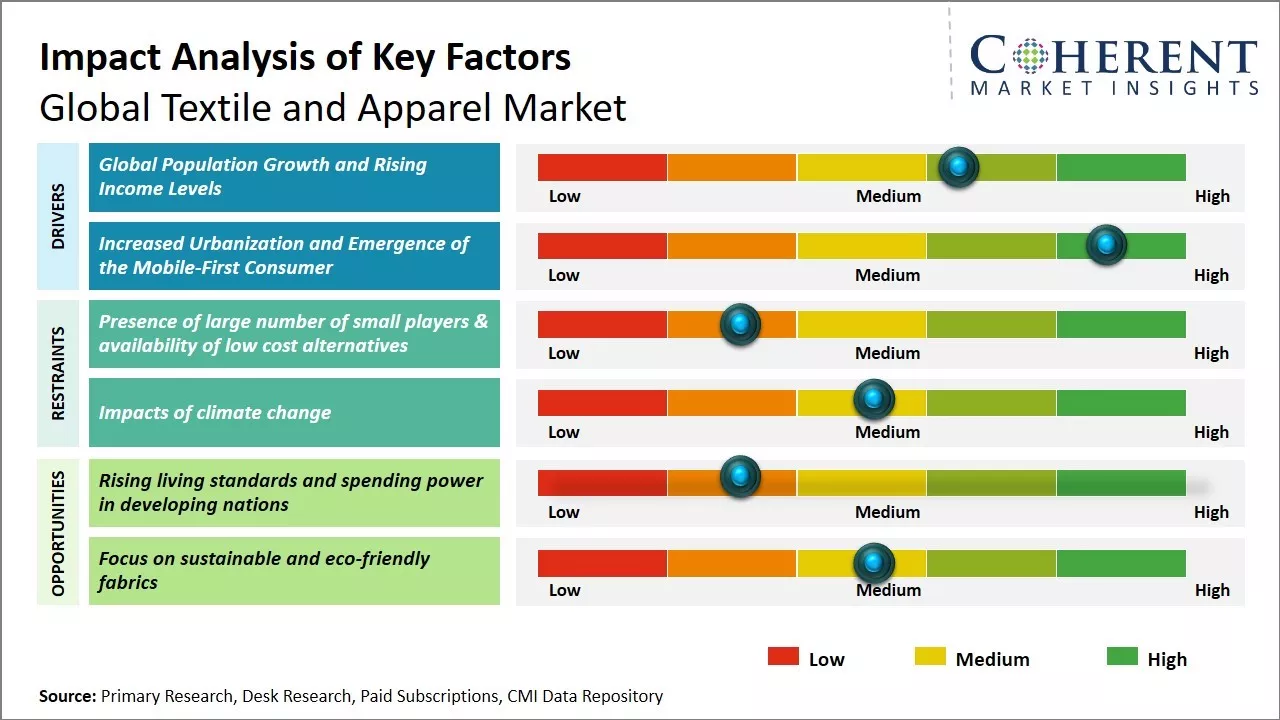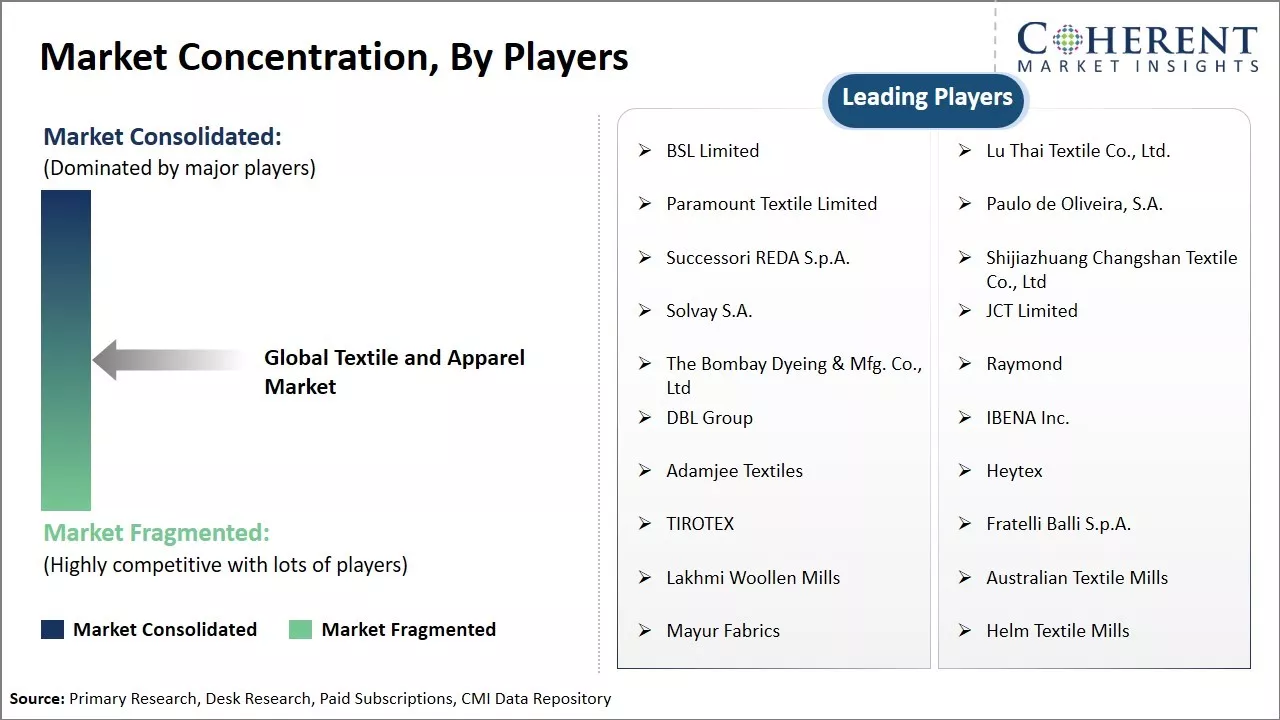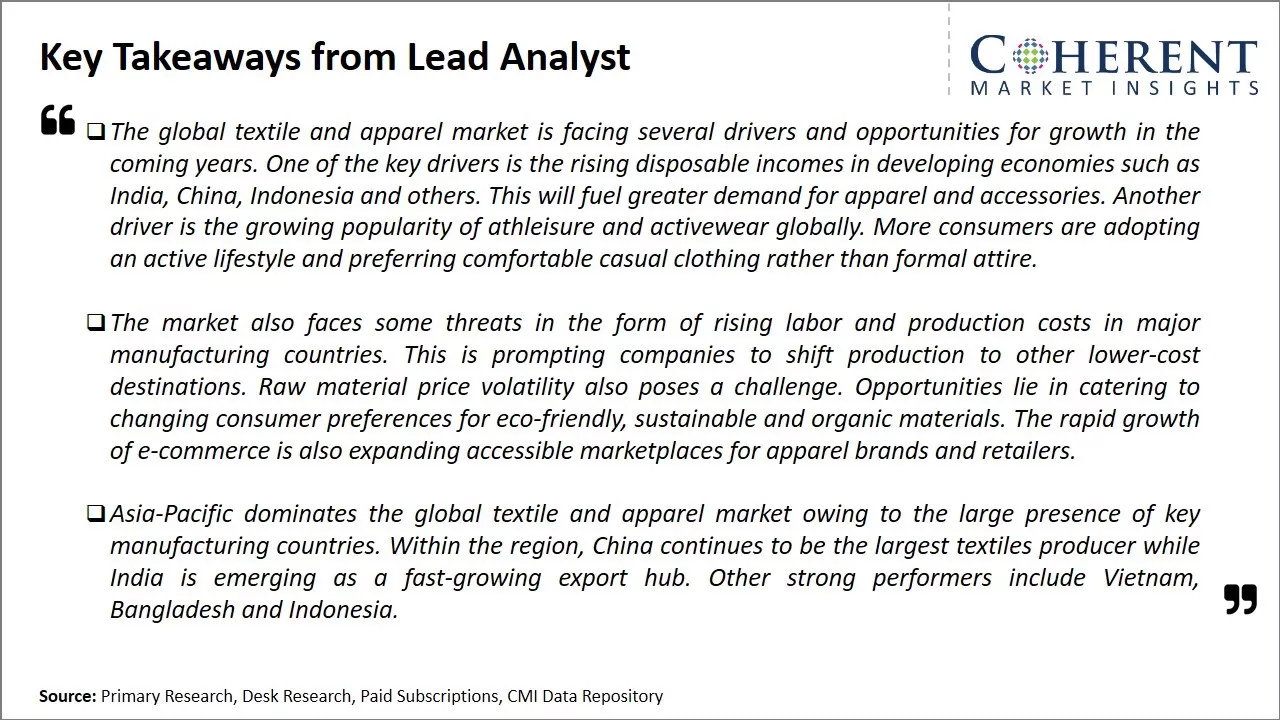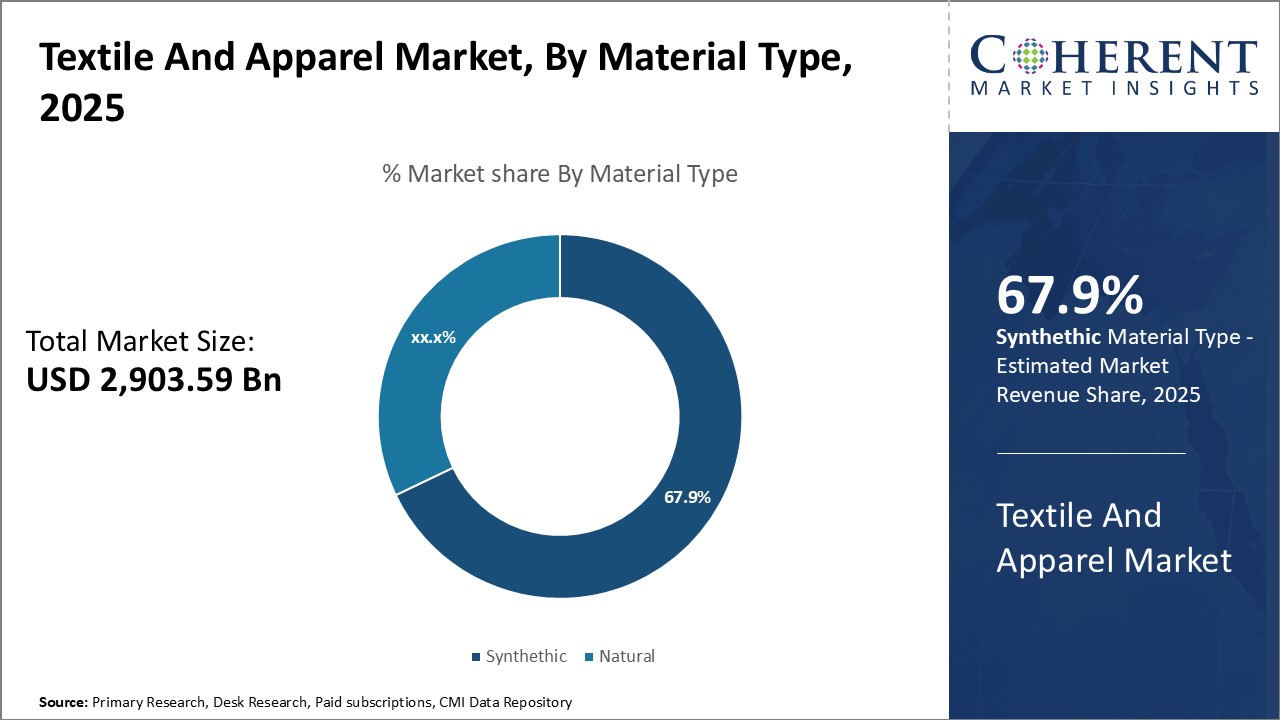Global textile and apparel market is estimated to be valued at USD 2,783.62 Bn in 2024 and is expected to reach USD 3,687.78 Bn by 2031, exhibiting a compound annual growth rate (CAGR) of 4.1% from 2024 to 2031.

To learn more about this report, request a free sample copy
Emerging markets such as India and China is expected to boost demand for textiles and apparel. Furthermore, rising population, increasing disposable incomes, and changing fashion trends can drive the market growth. However, price fluctuations of raw materials and growing environmental concerns around synthetic textiles can hamper the market growth.
Global Population Growth and Rising Income Levels
The population of the world continues to grow at a steady pace, placing upward pressure on demand for textiles and clothing. According to the data by United Nations in 2020, the global population reached 7.7 billion in 2019 and is projected to increase to nearly 10 billion by 2050. With population expansion comes more consumers with growing spending power and a need for basic items like fabrics, apparel, and household goods made from textiles. At the same time, incomes are rising around the world, especially in populous emerging markets. As living standards improve in these areas, consumers have more disposable income to allocate toward nonessential purchases beyond mere subsistence needs. Clothing and fashion have become desirable luxury items rather than just functional necessities. Consumers can afford to replenish their wardrobes more frequently with season- and trend-driven apparel rather than wearing articles until it fully deteriorate. People seek upgraded textile materials and finer craftsmanship rather than just bare basics to reflect their higher social status. Particularly in Asia, the burgeoning middle classes in large developing nations represent enormous untapped potential demand. Local fashion sensibilities are evolving beyond simple utilitarian needs to incorporate more elaborate styles influenced by global trends. Brand names and designer labels take on greater prestige and cachet. Apparel consumption rises dramatically as a symbol of modernization and economic progress. The sheer number of new potential consumers gaining the economic freedom and psychographic readiness to actively participate in the retail market cannot be ignored.

To learn more about this report, request a free sample copy
Increased Urbanization and Emergence of the Mobile-First ConsumerIncreased urbanization around the world has truly accelerated the rise of a mobile-first consumer mindset and behavior. With more people living in densely populated urban centres, on-the-go lifestyles have become the new normal. Fast paced cities mean consumers now rely heavily on their smart devices not just for everyday communication but also for all of their needs including shopping, payments and more. This fundamental shift to a mobile-first approach has massively disrupted the textile and apparel industry. Traditionally known for its brick-and-mortar stores, outdated inventory management and slow adoption of technology, the sector is now experiencing a digital transformation at rapid pace in response to evolving consumer preferences and habits. Apparel brands and retailers are investing heavily in their own e-commerce channels, streamlining their supply chains for faster turnarounds, implementing inventory management tools and ramping up their social media and influencer marketing presence. The entire buying and shopping journey is now optimized for smartphones with features like virtual and augmented reality options for trying outfits digitally, mobile payments and even delivery directly to consumers on the go.

To learn more about this report, request a free sample copy
Challenge: Presence of large number of small players & availability of low cost alternativesThe global textile and apparel market is currently facing growth challenges due to the presence of a large number of small players and availability of low-cost alternatives. While the sector provides livelihood to millions of people worldwide, the fragmented nature of industry makes it difficult for big brands to capture a large market share and achieve economies of scale. There are thousands of small textile mills, weavers, tailors and embroidery workshops operating across the globe, especially in developing regions. These small entities collectively hold a major chunk of the market. However, functioning with low capital and outdated machinery, they are only able to produce inexpensive, low-quality products and survive on tight margins. This flooding of the market with cheap alternatives limits the scope of premiumization and inhibits growth trajectory of organized textile players.
Opportunity: Rising living standards and spending power in developing nations
Rising living standards and spending power in developing nations will present significant opportunities for the global textile and apparel market in the coming years. As per projections by the World Bank, the proportion of middle-income consumers in developing countries will rise substantially by 2025. These consumers will have greater discretionary spending capacities and demand for variety in clothing and fabric types. The increase in average household incomes in Asia and Africa provides immense scope for textile and clothing brands to tap into this consumer base. For instance, according to data by the African Development Bank, average annual household income in Nigeria grew by over 10% between 2020-2022 to reach USD 6,200. Similarly, household income levels rose steadily in Bangladesh and Vietnam over the same period. As disposable incomes swell, demand for upgraded apparel and home textiles from these markets will see exponential growth. Local retailers and international brands must design and develop products that meet the aspirations of this emerging middle class.

To learn more about this report, request a free sample copy
Insights, By Material Type: Synthetic contributes the highest share of the market due to its superior functional propertiesAmong material type, synthetic segment is estimated to hold 67.4% market share in 2024. Synthetic materials have gained prominence over natural materials like cotton due to their excellent functional properties. Synthetic fibers are known for their versatility, durability, ease of dyeing and printing, wrinkle resistance and quick drying nature. These properties make synthetic materials very suitable for a variety of textile and apparel applications. The enhanced functionalities of synthetic materials also find extensive usage in workwear, industrial textiles and home furnishing products. The ease of processing synthetic fibers into yarns and fabrics at large scales have enabled mass production of affordable apparel and textiles. Synthetic materials are also gaining popularity in high-fashion textiles and designer apparels owing to their versatility to mimic natural textures and appearances.
Insights, By Application: Clothing Textiles accounts for the highest share of the global textile and apparel market due to the scale of clothing industry worldwide
Among application, clothing textiles segment is estimated to hold 42.2% market share in 2024. Consumption of clothing textiles far outweighs demand from other textile segments globally. This large-scale dominance of clothing textiles arises due to universal need for apparel across all nations and consumer segments. While technical, fashion and home textiles each have their target industries and applications, clothing remains indispensible for every individual. Basis the worldwide human population estimates, the potential market for basic apparel itself is immense. With rising incomes and improving standards of living in emerging economies, clothing consumption has grown significantly over the last few decades. Advancements in fast fashion retailing has boosted short product lifecycles and higher apparel purchases worldwide. Developed as well as developing regions alike have flourished their domestic clothing industries to cater to this massive global demand. Established clothing hubs exist worldwide, each contributing majorly to overall textile production and trade volumes.

To learn more about this report, request a free sample copy
Asia Pacific is expected to dominate the global textile and apparel market over the forecast period with estimated 38.4% share in 2024. The textile and apparel industry in India has a strong domestic market and a strong export demand. The government is investing in upgrading the infrastructure of the textile industry. The government has introduced schemes like MITRA and PLI to promote the industry. The government is also integrating advanced technologies into the production process. The government is also working on the Technology Upgradation Fund Scheme. These factors are expected to help India achieve global dominance in the textile and apparel industry.
North America is expected to witness fastest growth in the market over the forecast period owing to the strong growth of textile sector in the U.S. The U.S. is the second-largest exporter of textile-related products in the world.
Textile and Apparel Market Report Coverage
| Report Coverage | Details | ||
|---|---|---|---|
| Base Year: | 2023 | Market Size in 2024: | US$ 2,783.62 Bn |
| Historical Data for: | 2019 to 2023 | Forecast Period: | 2024 To 2031 |
| Forecast Period 2024 to 2031 CAGR: | 4.1% | 2031 Value Projection: | US$ 3,687.78 Bn |
| Geographies covered: |
|
||
| Segments covered: |
|
||
| Companies covered: |
BSL Limited, Lu Thai Textile Co., Ltd., Paramount Textile Limited, Paulo de Oliveira, S.A., Successori REDA S.p.A., Shijiazhuang Changshan Textile Co., Ltd, Solvay S.A., JCT Limited, The Bombay Dyeing & Mfg. Co., Ltd, Raymond , DBL Group, IBENA Inc., Adamjee Textiles, Heytex , TIROTEX, Fratelli Balli S.p.A., Lakhmi Woollen Mills, Australian Textile Mills, Mayur Fabrics, Helm Textile Mills |
||
| Growth Drivers: |
|
||
| Restraints & Challenges: |
|
||
*Definition: The global textile and apparel market includes companies that manufacture fiber, yarn, textiles, and other items that are used to produce clothing, home textiles like towels and bedding, accessories like bags and shoes, and other fashion goods. This market encompasses the design, production, and distribution of all natural and synthetic fabrics as well as finished apparel and accessories sold around the world.
Frequently Asked Questions
Joining thousands of companies around the world committed to making the Excellent Business Solutions.
View All Our Clients